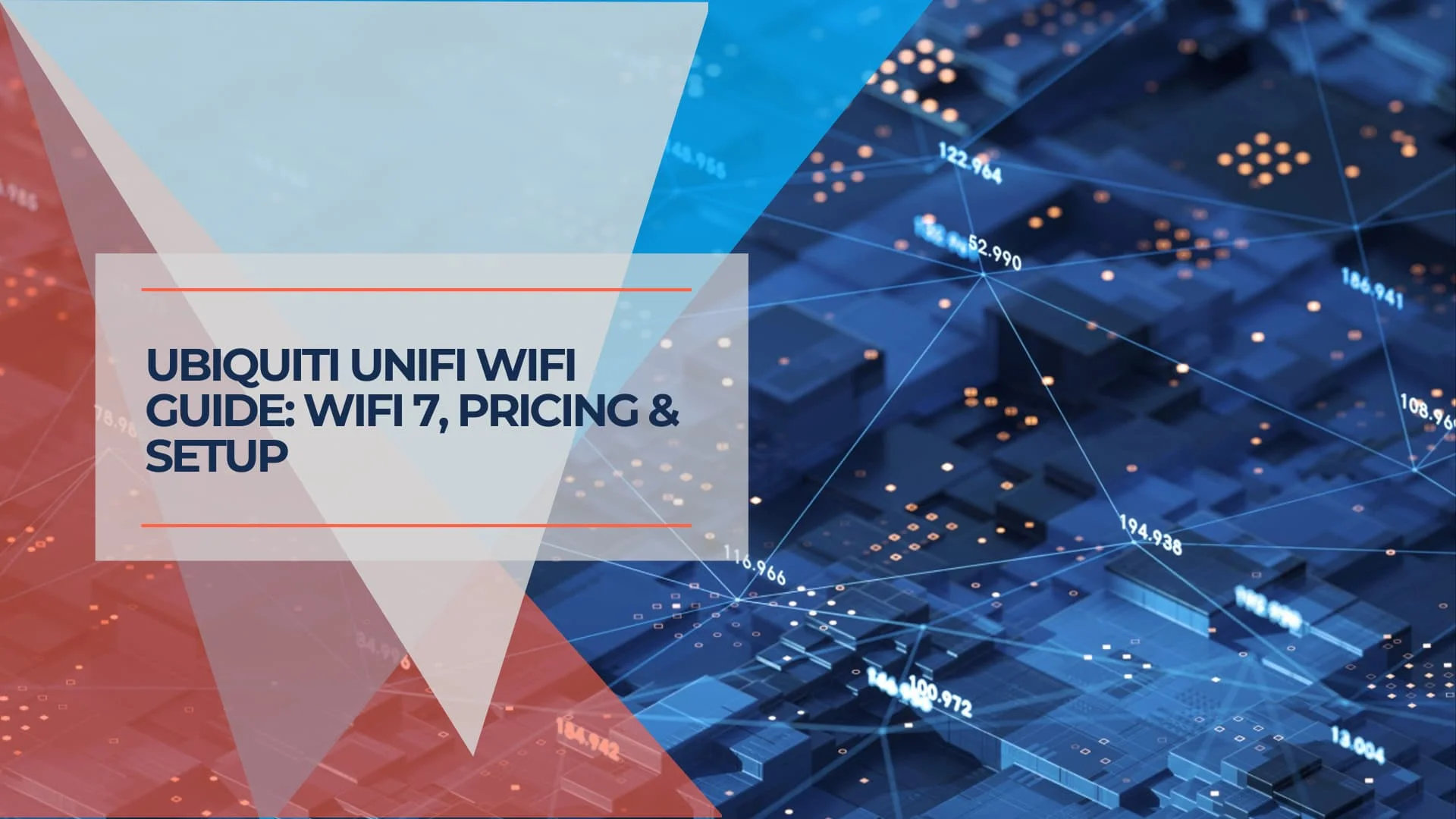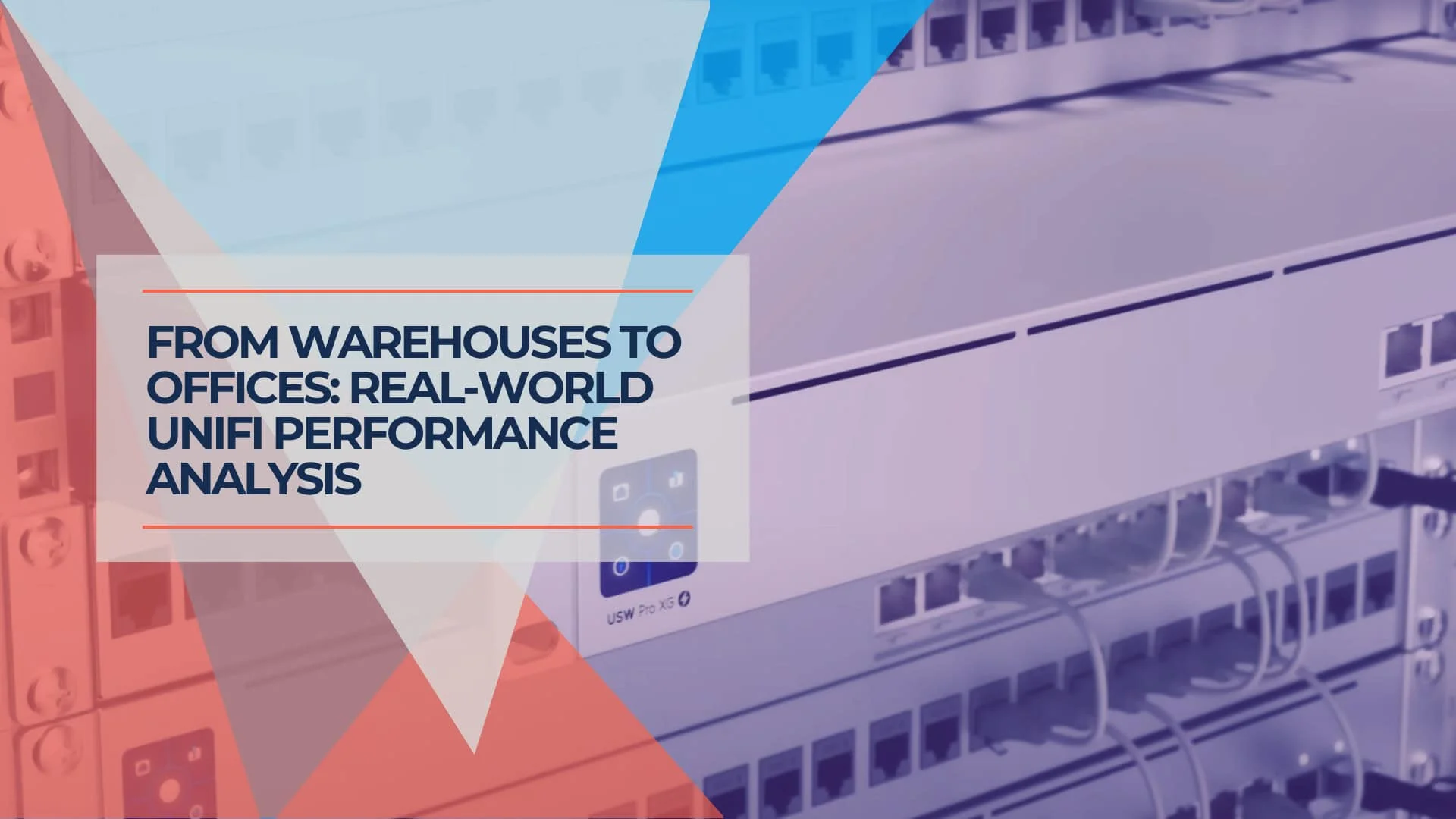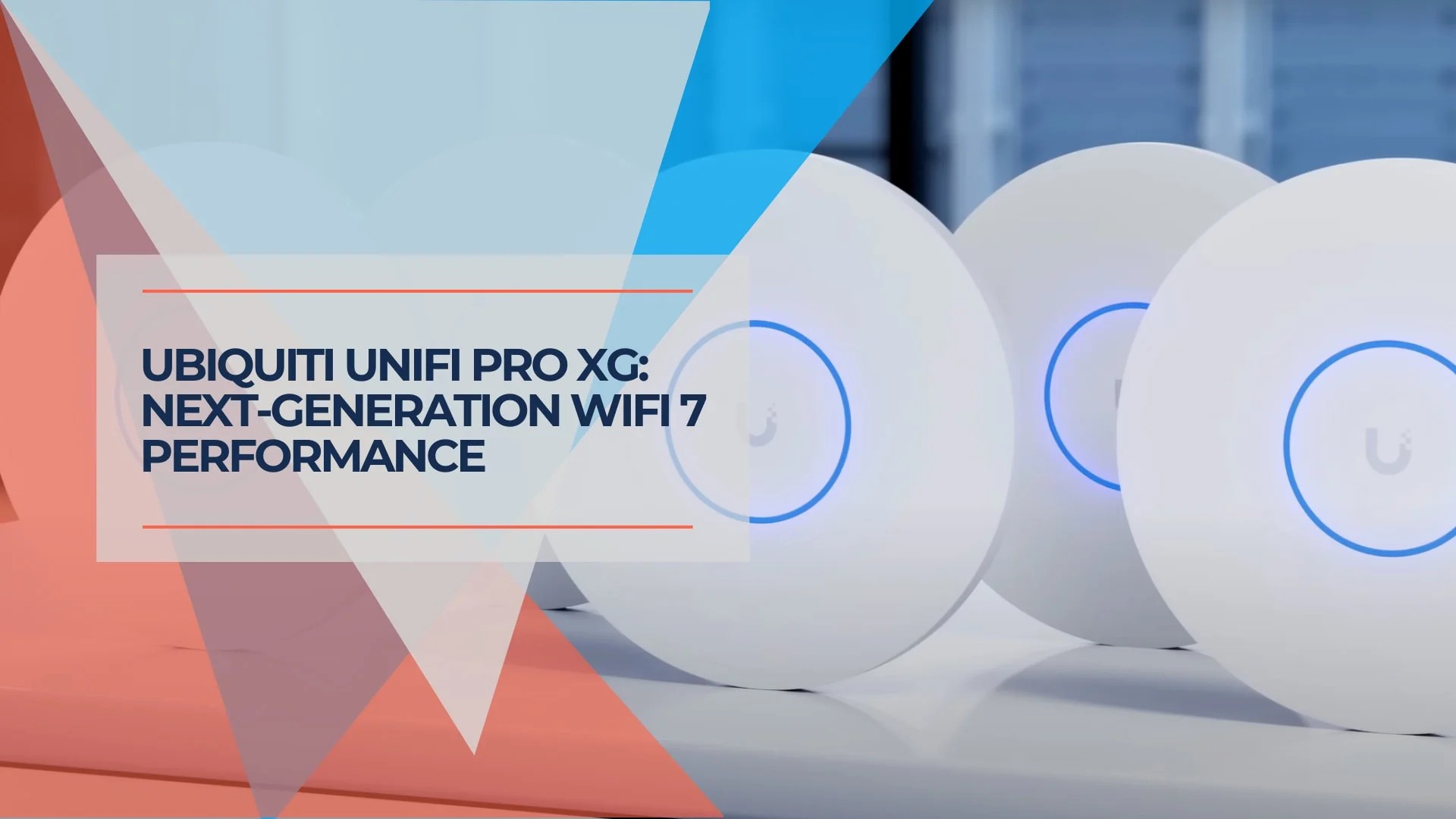Ubiquiti WiFi Solutions: Complete 2025 Business Guide
Complete guide to Ubiquiti UniFi WiFi solutions for business. Covers WiFi 7 access points, deployment scenarios, cost analysis, security features, and implementation best practices.


Affiliate Disclosure: This article contains affiliate links. If you make a purchase through these links, we may earn a small commission at no extra cost to you.
Key Takeaway
Ubiquiti's UniFi ecosystem offers business-grade WiFi solutions that bridge the gap between consumer equipment and enterprise systems. With WiFi 7 access points, centralized management, and scalable architecture, UniFi provides professional networking capabilities at accessible price points for businesses ranging from 5 to 500+ employees.
Understanding Ubiquiti's Business WiFi Ecosystem
Ubiquiti Networks has established itself as a leading provider of networking solutions that serve the critical middle ground between consumer equipment and enterprise systems. Their UniFi platform delivers enterprise-grade capabilities through an integrated ecosystem of WiFi access points, network gateways, switches, and management software designed specifically for business environments.
Unlike traditional networking approaches that require separate management interfaces for each component, UniFi operates as a unified platform where all network elements work together seamlessly. This integration provides businesses with professional networking capabilities while maintaining operational simplicity that doesn't require dedicated network engineers.
The UniFi Platform Architecture
The UniFi ecosystem centers around four core components that work together to create comprehensive business networks:
Network Gateways
Advanced routers and security gateways that serve as the central control point for network management, security policies, and traffic routing.
WiFi Access Points
Professional-grade wireless access points supporting the latest WiFi 7 standard with advanced features like band steering, load balancing, and interference mitigation.
Network Switches
Managed switching infrastructure with Power over Ethernet (PoE) capabilities to power access points and other network devices through data cables.
UniFi Network Management
Centralized software platform that provides real-time monitoring, configuration management, and analytics across all network components.
WiFi 7 Access Points: The 2025 Standard
Ubiquiti's 2025 WiFi 7 access point lineup includes support for the 802.11be standard, which provides measurable improvements in speed, capacity, and reliability compared to WiFi 6 and earlier standards.
UniFi U7 Series Overview
| Model | Streams | Max Speed | Client Capacity | Price (MSRP) |
|---|---|---|---|---|
| U7 Pro Max | 8 spatial streams | 8.6 Gbps | 500+ clients | $280 |
| U7 Pro XGS | 8 spatial streams | 8.6 Gbps | 500+ clients | $299 |
| U7 Pro XG | 6 spatial streams | 4.3 Gbps | 300+ clients | $199 |
| U7 Pro | 6 spatial streams | 4.3 Gbps | 300+ clients | $189 |
| U7 Lite | 4 spatial streams | 4.99 Gbps* | 200+ clients | $99 |
*U7 Lite is dual-band only (2.4 GHz + 5 GHz), lacks 6 GHz support
WiFi 7 Technology Advantages
The transition to WiFi 7 brings several key improvements that benefit business environments:
WiFi 7 Business Benefits
Multi-Link Operation (MLO) Enables devices to connect simultaneously across multiple frequency bands, reducing latency and improving reliability for mission-critical applications.
320 MHz Channel Width Increased channel width compared to WiFi 6E provides higher throughput for data-intensive business applications.
Enhanced QoS Advanced Quality of Service mechanisms ensure consistent performance for video conferencing, VoIP, and other real-time applications.
Improved Efficiency Better spectrum utilization and reduced overhead mean more effective use of available bandwidth in congested environments.
Important Note: 6 GHz Band Availability
Not all UniFi WiFi 7 models include 6 GHz support. The U7 Lite operates on only 2.4 GHz and 5 GHz bands, while models like the U7 Pro and above include tri-band capability with 6 GHz. Consider your need for 6 GHz when selecting access points, as many current business devices do not yet support this band.
Meet UniFi: Professional XG
Business Implementation Scenarios
Understanding how UniFi solutions apply to specific business environments helps organizations make informed networking decisions. Based on our deployment experience across diverse business environments, here are the most common and effective implementation scenarios.
Small Office Environments (5-25 Employees)
Small Office Configuration
Typical Requirements: Reliable WiFi throughout office space, guest network access, basic security features, simple management.
Recommended Configuration:
- Gateway: UniFi Cloud Gateway Ultra for centralized management
- Access Points: 1-3 UniFi U7 Pro units, depending on office layout
- Switch: UniFi Switch Lite 16 PoE for PoE power delivery
Estimated Investment: $800-$1,700, depending on office size and access point requirements.
Medium Business Deployments (25-100 Employees)
Medium Business Configuration
Typical Requirements: Multiple VLANs for department separation, guest networks, advanced security, centralized management, and high-density user support.
Recommended Configuration:
- Gateway: UniFi Dream Machine Pro Max for advanced features
- Access Points: 4-12 UniFi U7 Pro Max units for high-density coverage
- Switching: UniFi Switch Pro 24 PoE with additional switches as needed
Estimated Investment: $5,000-$15,000, depending on scale and advanced feature requirements.
Enterprise and Multi-Location Businesses
Enterprise Configuration
Typical Requirements: Site-to-site connectivity, centralized management across locations, advanced security policies, redundancy and failover capabilities.
Recommended Configuration:
- Gateway: Enterprise Fortress Gateway for maximum capabilities
- Access Points: Mix of U7 Pro Max and E7 Enterprise models
- Switching: UniFi Switch Pro Max 48 PoE with aggregation switches
Estimated Investment: $15,000+ per location with additional costs for SD-WAN and advanced security features.
Competitive Analysis: UniFi vs Traditional Solutions
Understanding how UniFi compares to other networking solutions helps businesses make informed technology decisions. Here's an objective comparison based on real-world deployment experience.
UniFi vs Consumer/Prosumer Solutions
| Factor | UniFi | Consumer Solutions |
|---|---|---|
| Scalability | Unlimited with centralized management | Limited to mesh nodes |
| Management | Professional interface with advanced features | Simple app with basic controls |
| Initial Cost | Higher upfront investment | Lower entry cost |
| Long-term Value | Excellent ROI with growth | Limited expansion capabilities |
| Security Features | Enterprise-grade with granular controls | Basic security options |
UniFi vs Traditional Enterprise Solutions
When compared to traditional enterprise networking vendors like Cisco, Aruba, or Ruckus, UniFi offers a different value proposition for small and medium businesses:
Cost Advantages
- No ongoing licensing fees for management software
- Significantly lower per-access-point costs
- Simplified purchasing without complex SKU matrices
- Reduced implementation costs due to simplified configuration
Considerations
- Limited enterprise-specific certifications compared to traditional vendors
- Support model relies more on community resources and documentation
- Some advanced enterprise features may not be available
- Third-party integration ecosystem is smaller but growing
Security and Management Features
UniFi's security capabilities have evolved significantly, particularly with the introduction of integrated threat protection and advanced network analytics. These features address the growing cybersecurity challenges facing modern businesses.
CyberSecure by Proofpoint Integration
The partnership with Proofpoint brings enterprise-grade threat intelligence directly to UniFi gateways. This integration provides:
Threat Detection Capabilities
- Signature-based Detection: Over 95,000 threat signatures updated weekly
- Behavioral Analysis: Machine learning algorithms identify unusual network patterns
- DNS Protection: Real-time blocking of malicious domains and command-and-control servers
- Intrusion Prevention: Advanced IPS capabilities with minimal performance impact
Privacy-First Approach: All threat analysis occurs locally on gateway hardware, ensuring that sensitive business data never leaves the organization's network. This approach provides security benefits while maintaining data privacy compliance.
Network Segmentation and Access Control
UniFi's VLAN and firewall capabilities enable businesses to implement sophisticated network segmentation strategies:
Guest Network Isolation Separate guest networks with customizable access policies, bandwidth limits, and time-based restrictions ensure visitor access doesn't compromise business resources.
Department Segmentation VLANs enable logical separation of different business functions while maintaining centralized management and controlled inter-department communication.
IoT Device Management Dedicated networks for IoT devices with restricted access help prevent security vulnerabilities from affecting critical business systems.
Cost Analysis and Budget Planning
Understanding the total cost of ownership for UniFi deployments helps businesses make informed financial decisions about their networking investments.
Initial Investment Components
| Component | Small Office (5-15 employees) | Medium Business (25-50 employees) | Large Deployment (100+ employees) |
|---|---|---|---|
| Gateway | $200-$500 | $600-$1,200 | $1,500-$3,000 |
| Access Points | $200-$600 | $800-$2,400 | $4,000-$15,000 |
| Switching | $300-$600 | $800-$2,000 | $3,000-$8,000 |
| Installation | $500-$1,500 | $2,000-$5,000 | $5,000-$15,000 |
| Total Range | $1,200-$3,200 | $4,200-$10,600 | $13,500-$41,000 |
Ongoing Operational Costs
One of UniFi's significant advantages is the minimal ongoing operational costs compared to traditional enterprise solutions:
No Licensing Fees
Unlike many enterprise solutions requiring annual licensing, UniFi management software and basic security features are included without ongoing subscription costs.
Optional Premium Services:
- CyberSecure by Proofpoint: $99 per year (55,000+ threat signatures)
- CyberSecure Enterprise: $499 per year (95,000+ signatures for large networks)
- UniFi Hosting: $25-$100 per month for cloud management
- Professional support: Available through certified partners
Implementation Best Practices
Successful UniFi deployments require careful planning and adherence to networking best practices. Based on our experience with numerous business installations, including detailed office network design strategies, here are the key considerations for optimal results.
Site Survey and Planning
Planning Essentials
Coverage Analysis Proper site surveys ensure optimal access point placement for comprehensive coverage without dead zones. Factors include building materials, interference sources, and user density requirements.
Capacity Planning Each access point supports different client capacities. High-density environments like conference rooms or open offices require careful planning to prevent performance degradation.
Future Growth Considerations The infrastructure should accommodate a 50-100% growth in device count and bandwidth requirements over a 3-5 year period.
Network Architecture Design
Proper network design prevents common issues and ensures scalable performance:
Hierarchical Design Core-distribution-access layer design principles apply even in smaller deployments, providing clear upgrade paths and simplifying troubleshooting.
VLAN Strategy Logical network segmentation improves security and performance while simplifying management of different device types and user groups.
Power and Connectivity PoE+ capability ensures sufficient power for high-performance access points while minimizing cable installation requirements.
Integration with Business Systems
Modern businesses require network infrastructure that integrates seamlessly with existing technology investments. UniFi's flexible architecture supports various integration scenarios with business software platforms and cloud services.
Cloud Service Integration
UniFi networks integrate effectively with major cloud platforms and business applications:
Cloud Integrations
Microsoft 365 Integration QoS policies can prioritize Microsoft Teams traffic, while VLAN configurations support hybrid cloud-local authentication scenarios.
Google Workspace Support Network configurations optimize performance for Google's cloud services while supporting Chromebook deployments in educational and business environments.
VoIP System Compatibility Voice traffic receives priority handling through advanced QoS mechanisms, ensuring consistent call quality across the network.
Security System Integration
UniFi's ecosystem approach extends beyond WiFi to include comprehensive business security solutions:
UniFi Protect Integration IP camera systems integrate directly with network infrastructure, providing centralized management and optimized performance for video surveillance.
Access Control Systems UniFi Access provides door control and visitor management that integrates with network user authentication and VLAN assignment.
Performance Optimization Strategies
Maximizing UniFi network performance requires understanding both technical capabilities and real-world optimization techniques.
WiFi 7 Optimization
Optimization Techniques
Channel Planning WiFi 7's support for 320 MHz channels requires careful spectrum analysis to avoid interference. The U7 Pro Max's dedicated spectral scanning engine provides real-time optimization recommendations.
Multi-Link Operation Setup Proper MLO configuration can reduce latency by up to 50% for compatible devices, particularly benefiting real-time applications like video conferencing and VoIP.
Band Steering Configuration Intelligent band steering guides devices to optimal frequency bands based on capability and current network conditions, maximizing overall network efficiency.
Network Monitoring and Analytics
UniFi's comprehensive monitoring capabilities enable proactive network management:
Real-time Analytics Traffic analysis, user behavior patterns, and application usage statistics help identify optimization opportunities and capacity planning needs.
Historical Reporting Long-term performance trends support informed decisions about network upgrades and optimization strategies.
Automated Optimization AI-driven features automatically adjust settings for optimal performance based on usage patterns and environmental conditions.
When to Choose UniFi vs Alternatives
While UniFi offers compelling advantages for many business scenarios, understanding when it's the optimal choice helps organizations make informed decisions.
UniFi is Ideal For:
Best Use Cases
- Growing businesses (5-500 employees) that need scalable solutions without enterprise complexity
- Organizations prioritizing unified management across networking, security, and communications
- Budget-conscious deployments requiring professional features without ongoing licensing costs
- Multi-location businesses benefiting from centralized management and SD-WAN capabilities
- Technology-forward environments implementing IoT devices and modern wireless standards
- Privacy-conscious organizations preferring local data processing over cloud-dependent solutions
Consider Alternatives When:
When to Look Elsewhere
- Maximum flexibility is required with extensive third-party integration needs
- Limited technical expertise is available for deployment and ongoing management
- Existing infrastructure represents a significant investment that cannot be replaced
- Compliance requirements mandate specific vendor certifications not available with UniFi
- Ultra-high density environments require specialized enterprise features
Future-Proofing Your Investment
Network infrastructure investments should serve businesses for 5-7 years minimum. UniFi's approach to technology evolution helps protect these investments, particularly when implementing multi-gigabit networking for future growth.
Technology Roadmap Alignment
Future-Ready Features
WiFi Standard Evolution WiFi 7 represents the current peak of wireless technology, providing significant headroom for future device and application requirements.
Multi-Gigabit Infrastructure 2.5 GbE and 10 GbE uplink capabilities ensure access points won't become bottlenecks as internet speeds increase.
Software-Defined Features Regular firmware updates add new capabilities without hardware replacement, extending equipment lifecycle and value.
Scalability Planning
Proper initial architecture supports growth without complete replacement:
Modular Growth Additional access points and switches integrate seamlessly with existing infrastructure, allowing organic expansion.
Gateway Upgrade Paths Higher-capacity gateways can replace existing units while preserving all configuration and device settings.
Feature Evolution New capabilities like enhanced security features and AI-driven optimization continue to be added through software updates.
Frequently Asked Questions
What's the difference between UniFi and AmpliFi product lines?
UniFi targets business and professional environments with advanced management capabilities, enterprise-grade security, and unlimited scalability. AmpliFi is designed for home users, prioritizing simplicity over advanced features. UniFi requires more technical knowledge but offers significantly more capabilities for business environments.
Do I need ongoing subscription costs for UniFi management?
No, basic UniFi network management is included without subscription fees. Optional services like CyberSecure by Proofpoint or cloud hosting require monthly fees, but the core networking functionality operates without ongoing costs.
How does WiFi 7 benefit business networks compared to WiFi 6?
WiFi 7 provides up to 4x the throughput of WiFi 6, reduces latency through Multi-Link Operation, and offers better performance in congested environments. For businesses, this translates to more reliable video conferencing, faster file transfers, and better support for bandwidth-intensive applications.
Can UniFi integrate with existing network infrastructure?
Yes, UniFi components can integrate with existing network infrastructure through standard protocols. However, maximum benefit comes from using UniFi components throughout the network for unified management and advanced features.
What level of technical expertise is required for UniFi deployment?
IT-savvy individuals can handle basic deployments using UniFi's setup wizards. However, professional installation and configuration services are beneficial for complex implementations with VLANs, advanced security policies, and multi-site configurations.
How does UniFi's security compare to enterprise solutions?
With CyberSecure by Proofpoint integration, UniFi provides enterprise-grade threat protection comparable to traditional enterprise solutions. The advantage is local processing for privacy and includes management software without licensing fees.
What warranty and support options are available for UniFi products?
UniFi products include a standard 1-year limited warranty. Extended warranty options are available through certified partners. Support includes community forums, extensive documentation, and professional services through authorized dealers and installers.
Conclusion: Making the Right Choice for Your Business
Ubiquiti's UniFi platform provides a networking solution for businesses seeking enterprise-grade capabilities without the complexity and cost typically associated with traditional enterprise solutions. The 2025 WiFi 7 lineup, combined with advanced security features and unified management, positions UniFi as a suitable choice for organizations ranging from small offices to multi-location enterprises.
Proper planning, realistic assessment of requirements, and professional deployment when needed are key to successful UniFi implementation. While the platform offers notable advantages in terms of cost-effectiveness, scalability, and feature richness, it performs best when implemented by organizations with appropriate technical expertise or professional support.
For businesses evaluating networking infrastructure investments, UniFi provides a foundation that can grow with organizational needs while maintaining operational simplicity. The combination of no ongoing licensing fees, regular feature updates, and modular scalability makes it a practical choice for many business networking scenarios.
Next Steps
Consider conducting a professional network assessment to determine the appropriate UniFi configuration for your specific business requirements. Proper planning and implementation help ensure maximum value from your networking infrastructure investment.
Related Resources
- UniFi Business Network Guide – Deployment fundamentals
- UniFi Office Network Blueprint – Design strategies
- Budget 2.5 Gbps UniFi Network – Multi-gigabit networking
- WiFi 7 Access Points Business Guide – Latest wireless technology
- Dream Machine Pro Max Review – Gateway deep dive
- UniFi Network Services – Professional installation
Related Articles
More from UniFi Networks

UniFi Network Solutions: 2025 Tech Overview
A comprehensive technical analysis of Ubiquiti's UniFi ecosystem for business networking and security. Covers gateways, WiFi 7 access points, CyberSecure, and real-world deployment experience.
13 min read

UniFi Gateway Selection Guide 2025: When You Need More Than Cloud Gateway Ultra
Complete UniFi gateway comparison from Cloud Gateway Ultra ($129) to Enterprise Fortress Gateway ($1,999). Learn exact thresholds for device count, throughput, and storage needs.
18 min read

UniFi Pro XG Review: WiFi 7 Performance & 10GbE Explained
Comprehensive review of Ubiquiti's U7 Pro XG and U7 Pro XGS WiFi 7 access points featuring 10 Gigabit Ethernet, MLO, and enhanced thermal design for business networks.
14 min read